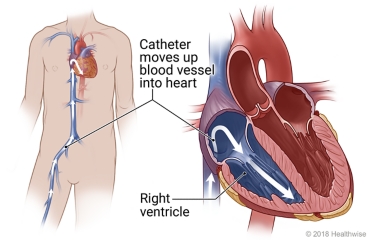What is a leadless pacemaker?
A leadless pacemaker is a small, battery-powered device. It sends mild electrical signals to your heart. This
keeps the heart beating normally. These signals are painless. The pacemaker can help stop the dizziness,
fainting, and shortness of breath caused by a slow heart rate.
A leadless pacemaker is a newer type of pacemaker. It's called leadless because no wires connect it to the
heart. It's placed in the heart's right ventricle, which is one of the heart's lower chambers. Other kinds of
pacemakers are placed under the skin of the chest. Those types are connected to the heart by wires.
If you are worried about having a pacemaker, it may help if you learn about how the pacemaker helps your
heart. Talk to your doctor if you have concerns.
How is it put in place?
You will get medicine before the procedure. It helps you relax and helps prevent pain.
Your doctor doesn't need to make any cuts to do the procedure. Instead, the doctor uses a thin tube called a
catheter. The pacemaker is placed inside the catheter. The doctor puts the catheter into a blood vessel in
your groin. You will get a shot to numb the skin where the catheter goes in.
Then the doctor moves the catheter through the blood vessel to the right ventricle of your heart. You may
feel pressure when the doctor does this. Your doctor may also have injected a dye into your blood vessel and
heart. The dye shows up on a screen. It helps your doctor see where to move the catheter and pacemaker.
When the catheter is inside the right ventricle, the doctor moves the pacemaker out of the catheter. The
pacemaker is attached to the heart tissue so that it doesn't move. Flexible hooks may be used. Then the
catheter is removed from your body.
What can you expect?
A leadless pacemaker can help you return to a more normal, more active life.
You'll need to use certain electric devices with caution. Some devices have a strong electromagnetic field.
This field can keep your pacemaker from working right for a short time. These devices include things in your
home, garage, or workplace. Check with your doctor about what you need to avoid and what you need to keep a
short distance away from your pacemaker. Many household and office electronics do not affect your pacemaker.
Your doctor will tell you how often your pacemaker should be checked. This is to make sure that it's working
right.
The battery life of a leadless pacemaker is up to 10 years or more. Its strength will be checked at follow-up
visits. The battery can't be recharged. If the battery gets low, you will need to decide whether to have
another procedure to replace the pacemaker.
Follow-up care is a key part of your treatment and safety. Be sure to make and go to all
appointments, and call your doctor if you are having problems. It's also a good idea to know your test results
and keep a list of the medicines you take.
Current as of: June 24, 2023
Content Version: 14.0
Care instructions adapted under license by your
healthcare professional. If you have questions about a medical condition or this instruction, always ask
your healthcare professional. Healthwise, Incorporated disclaims any warranty or liability for your use of
this information.


